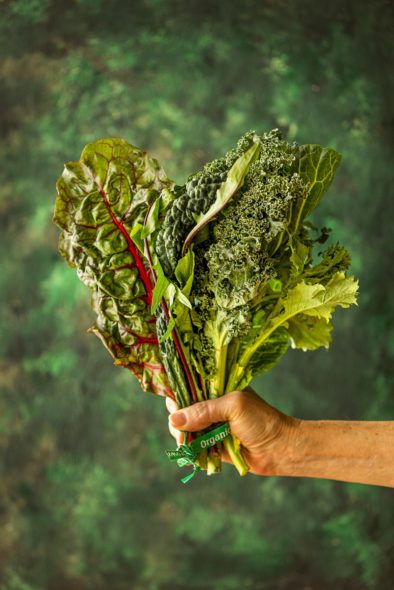
This is about cooked greens as opposed to “salad” greens. Cooked greens are not easily classified under one roof. The biggest group is the brassica or cabbage family, which includes kale, collards, broccoli rabe and mustard greens. Brassicas are native to Europe and Western Asia. Kale and the closely related collard greens probably originated somewhere in the eastern Mediterranean at least 2,000 years ago, though some believe collards may have originated in Asia, where they still grow wild. Kale also grows wild, but in northern Europe and England. Both kale and collards resemble the original cabbage, which did not form a head.
Cooked greens such as collards and kale are mainstays of American Southern cooking where they were usually cooked with smoked or salted pork. Mustard greens were also popular as a part of the “soul food” repertoire of Southern cuisine, sometimes combined with turnip greens.
There are many types of greens for cooking:
- Broccoli Rabe (also known as rapini) similar to broccoli with smaller stocks and florets. It has a pleasantly bitter, peppery flavor.
- Swiss chard: There are several varieties. It has an interesting tart flavor.
- Collard Greens: Wide green leaves whose leathery texture (and often size) can be reminiscent of elephant ears. Large bunches require long cooking, so look for ones with leaves as small as possible and stems that are not too thick. Collards have more of a cabbage-like flavor than other greens.
- Dandelion Greens: Local wild and field grown versions of this pleasantly biting green have smaller, more severely saw-toothed leaves than the mass-produced. varieties. Larger dandelion greens can be tough and quite bitter needing more cooking (up to 10 minutes) than the young varieties, which should be cooked quickly (as little as 3 minutes). If gathering your own, make sure the area hasn’t been sprayed with pesticides and the dandelions haven’t yet flowered.
- Kale: This sturdy green loves the cold and is often displayed outdoors because of tolerance to cold weather. When small and tender, kale can be used in salad mixes.
- Mustard Greens: As the name implies, it has a tangy, mustard-like flavor. Smaller leaf varieties such as baby red mustard greens are often found in salad mixes now common in supermarkets.
- Turnip and Beet Greens: While most are left attached to the root vegetable as an afterthought, some varieties of turnips are grown especially for their thin, dark greens. As with mustard greens, their sharp flavor (as well as their coarse texture) mellows with cooking.
When buying greens choose those that have good, green color with leaves that show no or little yellowing, withering or blemishes, and with stems that look freshly cut and are not thick, dried out, browned or split. Often greens are bunched so that the inner parts of the bunch are subject to decay and slime.
Yield will vary depending on the green. They all will shrink when cooked, sometimes to 1/8 of their original volume. As a rule of thumb, figure about 1/2 pound of raw, untrimmed greens per person if the greens are to be used as a side vegetable. That amount can be reduced if the greens are a component in a soup, stew or pasta.
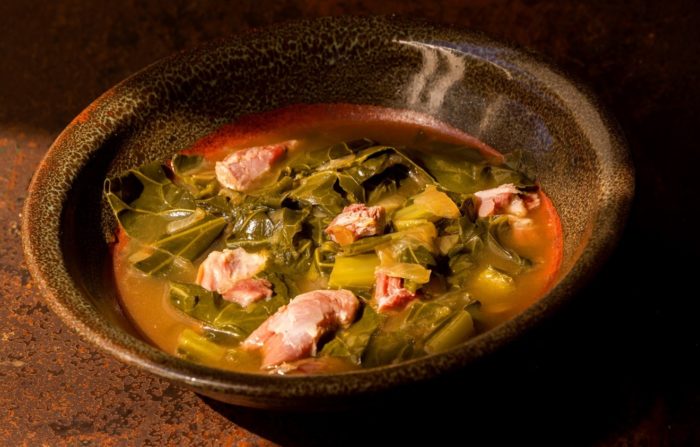
John Burgess Santa Rosa Press Democrat
COLLARDS WITH SMOKED PORK
Serves 4
This is normally a high fat dish and often the greens are cooked to death. Here, however, not such a long cooking time. The cooking stock is flavored with smoked pork and the broth consumed along with the greens.
1 smoked ham hock or shank, 1 1/4 pounds or so
1-quart defatted chicken stock
1 quart water
1 bay leaf
2 small bunches collard greens, about 1 1/2 pounds total
3 cloves garlic, chopped
1 small to medium onion, chopped
2 teaspoons vegetable oil
1/2 teaspoon kosher salt
1/4 teaspoon freshly ground black pepper
Hot pepper flakes or sauce to taste
Put hocks, stock, water and bay leaf in a large saucepan or pot, bring to a boil, cover and gently simmer 1-1/2 hours. Remove hocks and set aside. Chill or freeze liquid until any fat rises to the top and can be skimmed off.
Trim about 1/2 inch from the bottoms of the collards. Cut crosswise into strips, about 3/8 wide at the bottom and up to 1-inch wide toward the top. Wash thoroughly in a large tub of cool water. Drain.
In a large sauce pan or small stock pot, sauté onion and garlic in oil until soft. Add collards and stock and bring to a boil. Simmer, partially covered about 25 minutes or until the thickest stem pieces are tender. Season with salt and pepper and hot pepper to taste.
Meanwhile, remove all the fat and skin from the hocks and dice the lean meat. Remove collards with a skimmer to 4 shallow bowls or soup plates. Add 1/2 cup of broth to each bowl and sprinkle on diced pork. Make sure rustic country bread is on hand for dunking.
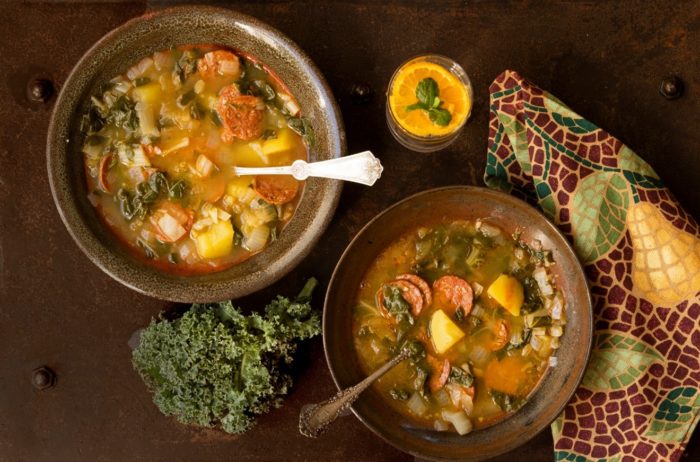
John Burgess Santa Rosa Press Democrat
POTATO AND KALE SOUP
Serves 6 – 8
Considered by many to be Portugal’s national dish, caldo verde is found everywhere — in the dining rooms of Lisbon’s most luxurious hotels to the humblest of country homes. It’s a versatile dish: Serve it as a one-course meal at lunch or as a light supper in the evening. Be sure to cut the kale is cut into very fine slices; that’s what creates the soup’s distinctive character. I’ve called for mashing the potatoes in the pot here but for a more sophisticated version you could puree in a food processor before adding the kale.
6 ounces chourico (cured chorizo) or other spicy cured sausage
3 tablespoons olive oil
3 cups (1 medium) white onion, peeled and cut into large dice
2 tablespoons finely sliced garlic
1 pound Yukon Gold potatoes
7 cups low salt, defatted chicken stock
3/4-pound young kale
Kosher or sea salt and freshly ground black pepper
Drops of hot sauce
Slice the sausage into thin rounds and then cut each round in half. In a heavy bottomed soup pot heat the olive oil over medium heat and cook sausage until it is nicely browned and crisp. Remove and drain on paper towels.
Add the onion and garlic to the pot and cook until they are just beginning to soften and lightly colored. Add the potatoes and the stock and bring to a boil. Lower heat and simmer until potatoes are just barely cooked through. Coarsely mash potatoes some of the potatoes with a potato masher or large fork.
Meanwhile roll kale and cut crosswise into very thin strips. Add to pot and cook until kale is tender, 10 minutes or so. Add the cooked chourico and season to taste with salt and pepper and drops of hot sauce if desired.
MARMALADE OF SPRING GREENS
Serves 6 – 8
This is adapted from a recipe by Paul Wolfert in her wonderful book Mediterranean Grains and Greens. It’s great as a topping for crostini or bruschetta and terrific as a flat bread topping. I also often stir into cooked pasta.
2 pounds spinach, escarole, Swiss chard, or a mixture of greens
1 garlic clove, peeled and lightly crushed
3 tablespoons extra virgin olive oil
4 anchovy fillets, drained and crushed with a fork
1½ teaspoons (preferably salted), rinsed and drained
1/4 cup chopped pitted Kalamata olives
1½ tablespoons golden raisins, soaked in warm water, drained and chopped
1/8 teaspoon chile flakes, or to taste
Wash the greens, remove their stems or stalks, and drain. Bring a pot of salted water to a boil. Cook the greens until thoroughly tender, 3 or more minutes. Drain, refresh in cold water, drain again and squeeze out excess water.
In a skillet, fry the garlic in olive oil over medium heat until lightly browned. Remove garlic and discard. Add the anchovies and capers and fry, stirring until the anchovy dissolves, about 1 minute. Add the greens and cook, stirring, for about 2 minutes, or until the greens absorb the flavored oil.
Remove the mixture to a large cutting board, allow it to cool, then chop finely or pulse in a food processor with the olives, raisins, and pepper flakes. Serve warm or at room temperature
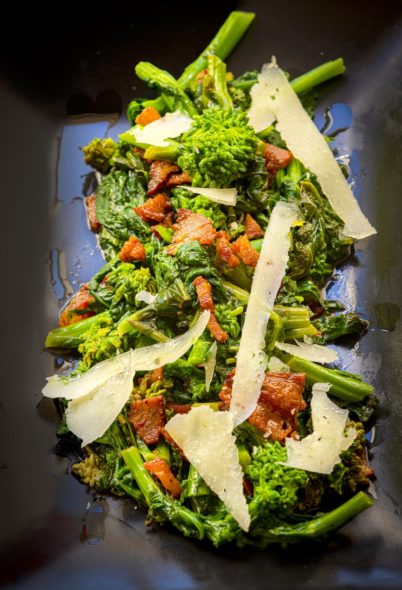
BROCOLLI RABE WITH PANCETTA AND PECORINO
Serves 4 to 6
This is a wonderful accompaniment to grilled and roasted meats, chicken and fish. I also like it as a topping for crostini and grilled country style bread.
1-1/2 pounds broccoli rabe, trimmed and cut into 2-inch lengths
2 tablespoons extra virgin olive oil plus more for drizzling
5 ounces diced pancetta
4 large garlic cloves, thinly sliced
1/4 teaspoon hot red pepper flakes, or to taste
1/2 cup dry white wine
3/4 cup freshly shaved Pecorino cheese (Romano, Toscano, etc.)
Sea or kosher salt and freshly ground pepper to taste
Bring a large pot of water to a boil. Add the broccoli rabe and blanch for about 2 minutes, until slightly softened. Drain. Shock in cold water, drain again and set aside.
Heat a large skillet over medium heat. Add the olive oil and when hot, add the pancetta and sauté until crisp, about 5 minutes. Set pancetta aside on paper towels to drain. Add garlic and red pepper flakes. Sauté for 1 minute, until the garlic and pepper flakes become fragrant. Deglaze the pan with wine until almost evaporated.
Add the broccoli rabe and sauté until tender but still retains its bright green color, about 3 minutes. Add the reserved pancetta. Remove from heat and toss with the cheese. Season to your taste with salt and pepper plus more olive oil if desired. Serve post haste
DANDELIONS WITH GARLIC AND OLIVE OIL
Serves 4
The best dandelion greens are local varieties. They don’t last long, so don’t dally before you enjoy them.
1 pound dandelion greens
2 tablespoons extra virgin olive oil
2 large cloves garlic, chopped
Kosher salt and freshly ground black pepper to taste
Trim off the roots and the very bottoms of any tough stems. Remove any leaves that are bruised or yellowed. Plunge leaves into a sink of cool water. Swish around and drain on a colander. Repeat process.
Bring a 5-quart pot of water and a tablespoon of salt to a boil. Add the dandelions and cook 5 minutes. Remove with a skimmer (if you want to save the cooking liquid) or drain in a colander. Gently squeeze out any excess moisture.
In the same pot, heat oil and add garlic over medium heat. When the garlic is just turning golden, add the dandelion. Toss well, coating with oil and garlic. Add salt and pepper and toss again.
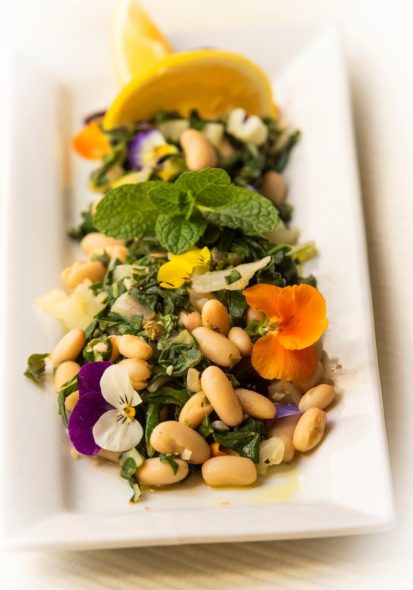
John Burgess Santa Rosa Press Democrat
SWISS CHARD AND WHITE BEAN SALAD
Serves 4 – 6
1 large or 2 smaller bunches Swiss chard, about 1 1/2 pounds
1 15-ounce cans cannellini beans, rinsed and drained
3 tablespoons lemon juice
3 tablespoons extra virgin olive oil plus more for drizzling
1 clove garlic, finely minced
2 teaspoons soy sauce
1/3 cup scallions, thinly cut on the bias
1 tablespoon drained, chopped capers
1 tablespoon chopped fresh mint
Kosher salt and freshly ground black pepper to taste
Separate chard stems from leaves. Stack and roll leaves, cigar style, into 1/2-inch strips. Cut stems crosswise into 3/8-inch-wide crescents. Wash in lots of cool water. Drain.
Put stems in a steamer basket over 1inch of boiling water in a large saucepan. Cover and cook 5 minutes. Add leaves and cook 3 minutes more. Drain and gently squeeze out any excess moisture from the leaves.
Put chard in a bowl with beans. Combine remaining ingredients in a small bowl, stir to combine and pour over chard and beans. Toss and chill for at least 1 hour before serving.
John Ash © 2022
PD

